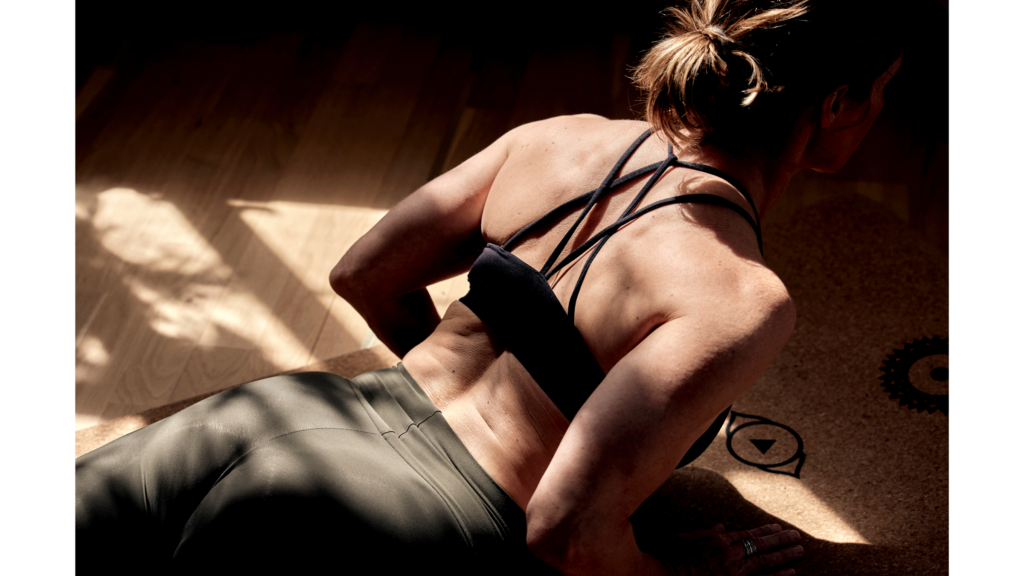
“], “filter”: { “nextExceptions”: “img, blockquote, div”, “nextContainsExceptions”: “img, blockquote, a.btn, a.o-button”} }”>
Heading out the door? Read this article on the new Outside+ app available now on iOS devices for members!
>”,”name”:”in-content-cta”,”type”:”link”}}”>Download the app.
For 18 years, I’ve experienced lower back pain. Prior to that, I pushed myself to take each yoga pose to the max without a twinge or even an ache. Everything changed not long after giving birth to my second son. One day while I was carrying him in the BabyBjorn, I leaned over to get laundry out of the dryer with straight legs rather than bent knees. The next morning, I couldn’t get out of bed.
Thus began years of on-and-off back pain that destroyed plenty of nights’ sleep, ruined some yoga sessions, and made me feel like I was a hundred years old. Some days I felt like lying on the couch and never getting up.
The last thing I wanted to do was move, but doing nothing was the worst thing I could do for my back. Still, when I went back to yoga class, many of the same movements that I had always done with ease exacerbated my pain and limited my ability to practice.
How I Learned to Modify My Yoga Practice
I turned to physical therapist, Ted Weber, who has practiced yoga for more than 20 years and helped other injured yogis adapt their practice for more than 16 years.
Weber says he sees a couple common patterns in patients with back pain. There’s the overly flexi-bendy yogis like me, who rely on ligaments and bones to hold poses instead of engaging their core muscles. Because of our natural flexibility, we’re inclined to take ourselves deeper into poses, which can place extra stress on our joints and connective tissues, including those lax ligaments. An overreliance on our flexibility results in underdeveloped muscles in the core that would otherwise help us maintain the shape of a pose.
Weber also sees yogis whose back pain arises from tight hips. These practitioners often overextend or hunch their backs to go farther into poses. By pushing their bodies too far to find a shape, they exert more force on the spine than it can handle.
Both scenarios—the flexible yogi and the tight yogi—can lead to increased pressure on the back and the potential for pain. As Weber explains, both types of situations can benefit from learning how to engage the core during yoga.
I was accustomed to hearing well-intended yoga instructors tell me to engage my core. But it wasn’t clear to me exactly what that means and how it should feel in different yoga poses. So I asked my physical therapist to talk me through how to do this correctly in various poses.
For me, building strength and stability through the midsection and all around my lumbar spine eased my pain and helped me build a far more resilient back. This required needing to drop my ego, which took the form of a little voice inside my head that wanted to push me farther into a pose and compromise my spine. Instead, I needed to rely on core strength to hold poses rather than just my uber flexibility.
5 Ways to Protect Your Back From Low Back Pain
When I asked Weber how to engage my core to protect and strengthen my back in a variety of poses, he explained that some poses, such as Plank and Side Plank (Vasisthasana), do this innately. Other poses require more intentionality. The following tweaks to common yoga poses can help you focus on engaging your entire core in a manner that’s safe for your back.
Although back pain is common, it’s unique for each of us. Whether you experience a subtle ache, dull throbbing, or intense pangs, it’s important to consult with your healthcare provider prior to continuing your yoga practice.
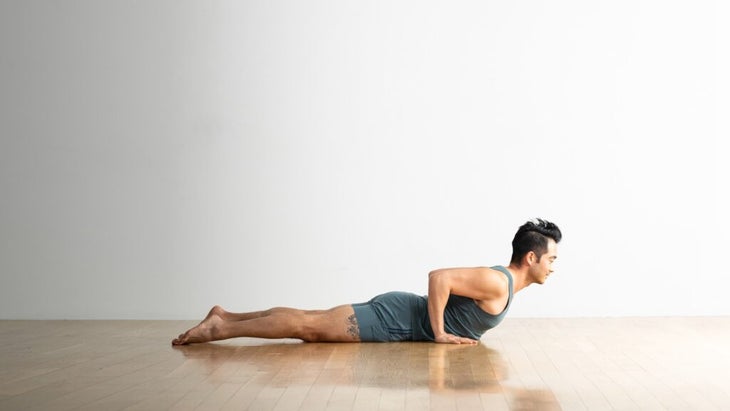
1. Backbends
We often focus on attaining the shape of a backbend rather than considering how we get into the backbend. When you push into your hands and feet to find the shape at any cost, chances are you’ll hinge sharply at the lower back, which will exacerbate back pain. You can use your abdominal muscles to control the bend and distribute the force throughout the spine as opposed to concentrating the movement in a few vertebrae.
For most backbends, try to tilt your pubic bone upward and tighten your lower pelvis muscles. Then broaden through your chest and shoulders. This may mean your backbend isn’t as apparent. You’ll still benefit from the backbend but without the compression and strain on your lower spine.
In Upward-Facing Dog Pose (Urdhva Mukha Svanasana), for example, tuck your pelvis and bend throughout your back. Press firmly into the tops of your feet and really engage your tummy muscles. Keep your spine in one gradual line.
If Wheel Pose (Urdhva Dhanurasana) is uncomfortable or even impossible, try to hang out in Bridge Pose (Setu Bandha Sarvangasana) as you squeeze your glutes and tighten your stomach muscles so you’re engaging your abs instead of compressing your lower back.
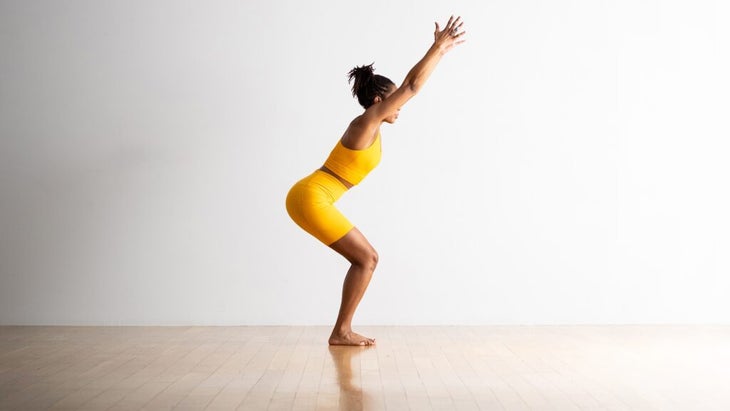
2. Chair Pose
It’s easy to overextend your back in Chair Pose (Utkatasana). When you lift your arms, you tend to arch your lower back. Strong core muscles can prevent overextension of the spine. Pull that pubic bone upward to avoid overarching. Consider keeping your hands in prayer at your chest so you don’t exert undue pressure on your back.
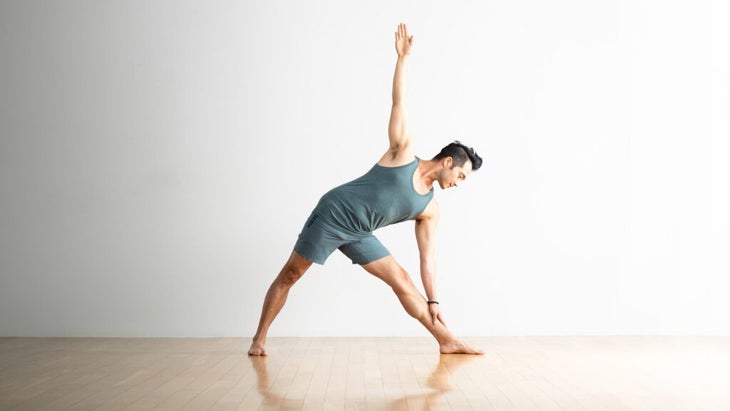
3. Triangle Pose
People with tight hips often compromise their back in Triangle Pose (Trikonasana) by bending or arching it in an attempt to touch their fingers to their shin or mat. Instead, keep the spine straight, parallel to the mat, and move into the pose only until your hips bend as far as possible. From there, use your core muscles to keep your spine straight and support yourself in the pose.
This may mean not going as deep into the pose as you might want to go or think you need to go. When you reach that place in your back, that’s when you rest your hand wherever it is. Weber cautions that using a block can actually push you too far into the pose if you’re bending your back to reach it. Instead, use a light touch of your hand on your front leg to help keep your spine straight.
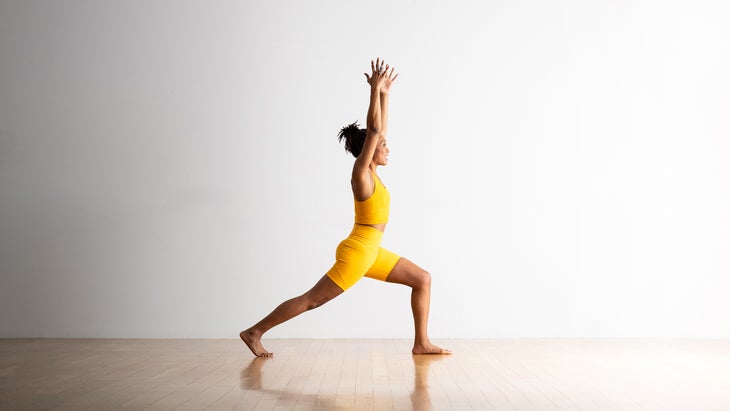
4. High Lunge
Similar to Chair Pose, High Lunge can cause an excessive arch in your lower back. There will naturally be a slight curvature in the spine during this pose, but to prevent it from being compressive, tighten the abdominal muscles and tuck your pelvis. Drawing the tailbone toward the floor intensifies the hip flexor stretch and relieves compression in your low back.
5. High Lunge Twist with Prayer Hands
In High Lunge Twist with Prayer Hands, people tend to hunch their upper body to get their elbow around their knee. Instead, keep the spine long as you twist, even if that means that you can’t hook your elbow on the knee. Tuck your pelvis and rotate to twist with a straight back, as if a string is pulling the crown of your head toward the front of the room as you keep pressing through the heel of your straight leg. This way, you’re not trying to hunch your back to force yourself deeper into the pose. The same applies to similar twists, including Revolved Chair Pose.
About Our Contributor
Jennifer Alsever is a longtime Colorado journalist and author who has practiced yoga for 20 years. She has contributed to the New York Times, Fast Company, Fortune, the Wall Street Journal and more and is also the author of five award-winning young adult novels. She enjoys writing, reading, skiing, mountain biking, hiking, yoga, and wake surfing. She is also a certified Reiki Master. You can see Jennifer’s work at www.jenniferalsever.com.





